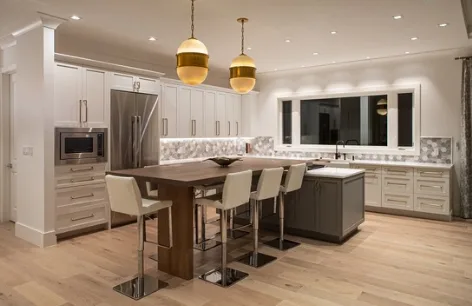Lighting is one of the most powerful tools in interior design, yet it’s also one of the most overlooked. Homeowners often invest heavily in furniture, finishes, and décor, only to find their rooms feel flat, cold, or just “off.” More often than not, the culprit is lighting. If you want to create a space that feels elevated, intentional, and welcoming, it’s crucial to avoid common lighting mistakes that designers see time and time again. Below are five pitfalls—and professional fixes—that can transform your space from dim and disjointed to stunning and seamless.
5 Lighting Mistakes to Avoid

Design by Patricia Davis Brown Designs, LLC.
1. Skipping Layered Lighting
One of the most prevalent lighting mistakes is relying on a single light source in a room. Whether it’s an overhead fixture or recessed can lights, this approach flattens the space and leaves it lacking depth and visual interest. Every well-designed room needs three types of lighting: ambient (general lighting), task (for specific functions), and accent (to highlight focal points).
Designer Fix: Think in layers. For example, in a kitchen, combine recessed ceiling lights (ambient), under-cabinet lights (task), and pendant lights over the island (accent). This balance of lighting adds warmth, functionality, and dimension to any room.
2. Ignoring CRI (Color Rendering Index)
Color rendering is an often-overlooked element that can make or break how your design elements appear. The Color Rendering Index (CRI) measures how accurately a light source reveals colors compared to natural daylight. Low CRI lighting can dull your furnishings, distort paint colors, and even make people look unhealthy. Overlooking CRI is one of the more technical lighting mistakes that impact aesthetics in subtle but significant ways.
Designer Fix: Choose light sources with a CRI of 90 or above for living spaces. This ensures that your color palette shines as intended—crisp whites, vibrant artwork, and true wood tones all read beautifully under high-quality light.
3. Misjudging Kelvin Temperature
Another major contributor to common lighting mistakes is selecting the wrong Kelvin temperature, which determines the color tone of the light. Too warm (below 2700K), and your space can feel dated and overly yellow. Too cool (above 5000K), and your home can feel sterile and uninviting.
Designer Fix: Tailor your lighting temperature to the room’s function. For cozy areas like bedrooms and living rooms, aim for 2700K–3000K. For kitchens, bathrooms, and workspaces, 3000K–3500K offers a crisp, energizing tone without feeling too harsh. Mixing temperatures inappropriately is one of the more frequent lighting mistakes seen in DIY projects.
4. Poor Placement
A light fixture in the wrong place, even a beautiful one, can throw off an entire room. Whether it’s installing pendants too high, vanity lights at the wrong height, or over-lighting a small space, placement matters as much as the fixture itself. This is one of those lighting mistakes that can make a professionally designed room feel amateurish.
Designer Fix: Follow industry placement standards and tailor them to your space. For example, hang pendants 30–36 inches above a kitchen island, and ensure vanity lights are positioned at eye level to avoid casting shadows on the face. In living rooms, avoid placing recessed lights too close to walls, which can create distracting scalloped patterns. Strategic placement ensures a comfortable and cohesive light experience.
5. Lack of Control Options
Many people install great fixtures, only to leave themselves with just an on/off switch. Not incorporating dimmers, smart controls, or zoning capabilities is one of the most limiting lighting mistakes a homeowner can make. You’re left with the same intensity of light whether you’re reading, entertaining, or relaxing, no ambiance, no flexibility.
Designer Fix: Install dimmers wherever possible, especially in dining rooms, bedrooms, and media spaces. Consider smart home lighting systems that allow you to control zones, color temperatures, and intensity via phone or voice commands. This level of customization helps elevate the space and makes your lighting work for every mood and activity.
Final Thoughts
Avoiding these five lighting mistakes can be the difference between a room that looks good and one that feels incredible. Thoughtful lighting design enhances color, supports function, and sets the emotional tone for your entire home. Whether you’re renovating or refreshing a single room, take time to review your lighting plan and revisit this list of lighting mistakes before making your next purchase.
Remember: design isn’t just what you see, it’s how you see it.





